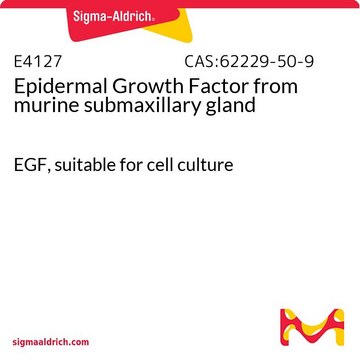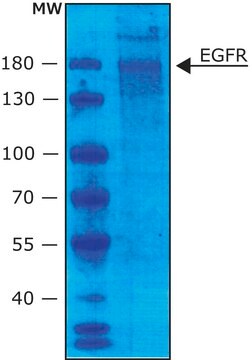E5036
Epidermal Growth Factor Protein, human
>97% (SDS-PAGE), recombinant, expressed in E. coli, lyophilized powder, suitable for cell culture
Sinónimos:
EGF
About This Item
Productos recomendados
product name
Factores de crecimiento epidérmico human, EGF, recombinant, expressed in Escherichia coli, >97% (SDS-PAGE)
biological source
human
Quality Level
recombinant
expressed in E. coli
assay
>97% (SDS-PAGE)
form
lyophilized powder
potency
0.08-0.8 ng/mL EC50
mol wt
~6 kDa
packaging
pkg of 200 and 500 μg
storage condition
avoid repeated freeze/thaw cycles
impurities
≤1 EU/μg Endotoxin
color
white
solubility
water: soluble 0.190-0.210, clear, colorless
UniProt accession no.
storage temp.
−20°C
Gene Information
human ... EGF(1950)
¿Está buscando productos similares? Visita Guía de comparación de productos
General description
Application
- as a supplement in in LHC-8 medium to culture liver cell lines
- in the fetal bovine serum (FBS)-Dulbecco′s modified essential medium (DMEM) /F12 medium for primary culture of human glioma cells
- as an additive in the conditional medium of normal fibroblasts (NFs) to study its effect on the migration and invasion of endometrial cancer (EC) cells
- as a component in tumorsphere medium
Biochem/physiol Actions
Citation
2. Gregory, H., Isolation and structure of urogastrone and its relationship to epidermal growth factor. Nature, 257, 325-327 (1975).
3. George-Nascimento, C. et al., Characterization of recombinant human epidermal growth factor produced in yeast. Biochemistry, 27, 797-802 (1988).
4. Todaro, G.J. et al., Transforming growth factors produced by certain human tumor cells: polypeptides that interact with epidermal growth factor receptors. Proc. Natl. Acad. Sci. USA, 77, 5258-5262 (1980).
5. Blomquist, M.C. et al., Vaccinia virus 19-kilodalton protein: relationship to several mammalian proteins, including two growth factors. Proc. Natl. Acad. Sci. USA, 81, 7363-7367 (1984).
6. Eppstein, D.A. et al., Epidermal growth factor receptor occupancy inhibits vaccinia virus infection. Nature, 318, 663-665 (1985).
Storage Class
13 - Non Combustible Solids
wgk_germany
WGK 2
flash_point_f
Not applicable
flash_point_c
Not applicable
Certificados de análisis (COA)
Busque Certificados de análisis (COA) introduciendo el número de lote del producto. Los números de lote se encuentran en la etiqueta del producto después de las palabras «Lot» o «Batch»
¿Ya tiene este producto?
Encuentre la documentación para los productos que ha comprado recientemente en la Biblioteca de documentos.
Los clientes también vieron
Nuestro equipo de científicos tiene experiencia en todas las áreas de investigación: Ciencias de la vida, Ciencia de los materiales, Síntesis química, Cromatografía, Analítica y muchas otras.
Póngase en contacto con el Servicio técnico










